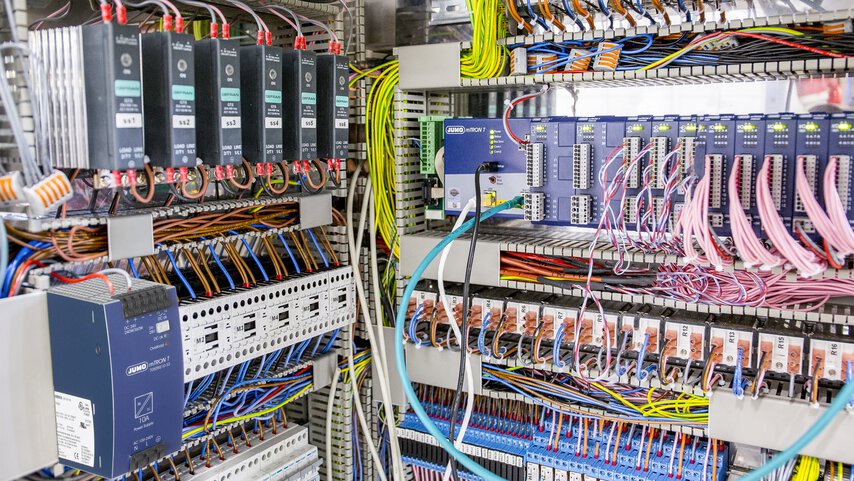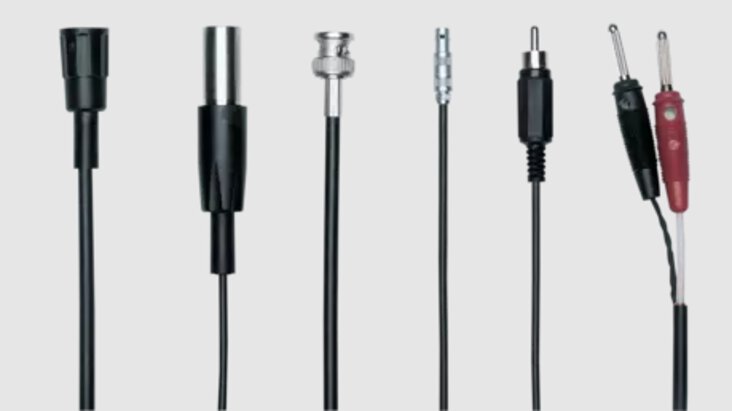

Colors and types of wires in automatic
The basis of automation is the control of machines and industrial processes. However, these activities could not be realised without ... wires and cables. There are so many types of them that it is impossible to describe them all in one article. So we discuss the most important types of cables in automation, their markings and colours, and give practical tips for selecting the right ones for your application. Check it out!
Cables and wires – what is the difference?
These terms are often confused because there is little difference in meaning between them. Using them interchangeably is not a serious mistake, but for the sake of accuracy let's clarify the difference:
-
wires - may or may not be insulated with solid material, are rated up to 6 kV and are only laid indoors (often in conduit sheaths)
-
cables - can be used across the entire voltage range and are always externally insulated, so can be laid in the ground or in water, for example
Types of wires and cables used in automation
The basic type of cables used in automation are power and control cables. These are used to supply power to a device from the mains or for control. Examples include temperature-resistant control cables, servo cables, motor control cables from an inverter or halogen-free cables or halogen control cables - fire-resistant cables that impede the flow of oxygen to the fire area and thus smother the flames.
With the development of digital technology, including Ethernet, data cables and fibre optic cables have gained in popularity.
It would be difficult to describe all types of cables and wires used in industrial automation in one article. We therefore present a general breakdown by type, purpose and design:
Veins
Quantity:
-
single-core
-
multicore
Type:
-
with aluminium conductors
-
with copper conductors
Shielding
-
shielded
-
unshielded
Twisted
-
twisted (twisted pair)
-
untwisted
Type of application
-
for fixed applications
-
for mobile applications
Material
-
cables made of polyvinyl chloride (PVC)
-
polyurethane (PUR) cables
-
POC cables
Control cables
Control cables are intended for connection to electrical equipment, equipment in electrical switching stations with alternating voltage (up to 600 V and frequency up to 100 Hz ) or direct voltage up to 1000 V at an ambient temperature of - 50 to + 50 degrees Celsius. С. Control cables are used to transmit electrical energy in control, signalling, regulation and protection circuits and in measurement systems.
Control cables may have conductors of cross-section from 0.75 to 10 mm2 made of a single copper or aluminium wire, number of conductors - 4, 5, 7, 10, 14, 19, 27, 37.
The conductors may be insulated with rubber, coated with PVC plastic, insulated with polyethylene. The conductors are sheathed and may be covered with an armour made of two steel strips and sometimes with a protective cover.
Control wires – cable colour coding
The control cables are marked as follows: X0X1X2X3X4 - X5X6, where Х0 is - core material: А - aluminium, copper is not marked, К - test, Х1 - core insulation material: Р - rubber, В - polyvinyl chloride, P - polyethylene, Ps - self-extinguishing polyethylene. X2 - sheath: V - polyvinyl chloride, VGE - polyvinyl chloride over common screen of aluminium or copper foil, H - non-flammable rubber (neurite), S - lead, X3 - armour: B - two steel bands, Bb - one profiled steel band, K - galvanised round steel wires with rubber insulation of conductors, Pb - also with PVC or PE insulation of conductors, X4 - protective armour cover: G - none, H - not profiled, Shv - PVC hose, X5 and X6 - number and cross-section of conductors, mm2.
Each control cable has stranded insulated conductors. Each strand has a counter core in blue or blue with a directional core in red or pink next to it.
The signal and interlocking cables are designed for railway circuits, fire automation, telegraph and other systems for 300 V AC and 700 V DC, at ambient temperatures from - 50 to + 60 deg. С.
Single-conductor cables
Their core consists of a single wire conductor (for fixed receivers) or a strand of more wires (for mobile receivers). They are most often made of copper, due to the strength, ductility and high conductivity of this material.
Examples of applications for single-wire cables:
-
control cabinets
-
portable welding equipment
-
cable harnesses
Multicore cables
Multicore cables consist of a number of single-core conductors, connected by a common outer insulation (protective layer). There is no limitation on the number of conductors, and in practice cables as large as 50 conductors can be found. A large number of different types of multicore cables and wires are available on the market, varying according to the application. Multicore cables are, like single-core cables, usually made of copper.
Examples of the use of multicore cables:
-
on plaster in dry areas
-
under plaster in dry rooms
Shielded cables
The use of shielded twisted-pair cables in electrical cables protects the signal transmitted via them from external or electromagnetic interference generated by electronic devices operating in close proximity. This electrical cable allow analogue and digital signals to be transmitted with negligible data loss. However, it should be remembered that shielded cables will only fulfil these functions if they are earthed.
The shield is usually made of aluminium foil, copper braid or aluminium braid. It can be single or double.
Examples of applications for shielded cables
-
advanced control and signalling systems
-
connection of measuring devices
-
hospitals, petrol stations, industrial halls and other places where it is necessary to minimise electromagnetic emissions outside the network
Unshielded cables
These are cables in which no screening has been applied either to the entire cable or to individual conductors.
Examples of usage of unshielded cables
Investments in which no greater resistance to electromagnetic interference is required.
Twisted pair cables (twisted pair)
Twisted pair cables consist of one or more pairs of wires twisted together. This procedure serves to eliminate electromagnetic interference and mutual interference (crosstalk).
A parameter which is of significance in the case of twisted pair cables is the so-called stranding pitch. The smaller it is, the greater the flexibility of the cable.
Examples of applications for stranded wires
Non-torsional (linear) cables
Torsion-free conductors are made of conductors which are placed evenly in relation to one another, without torsion.
Examples of usage of untwisted cables
Fixed receivers
Servo leads
Servo leads are used to control servomechanisms - devices that consist of an electric motor, electronics and a gearbox enclosed in a common housing. Servo leads often have to bridge long distances between the control cabinet and the drive and are therefore characterised by features such as:
-
low capacitance
-
attenuation
-
oil resistance
-
fire-resistant
-
resistance to uv radiation
Other types of control cables:
-
Halogen control cables
-
Halogen-free control cables
-
Cables for mobile consumers
-
Cables for fixed receivers
-
Cables for inverter-operated motors
Signalling and interlocking cables
Signalling and interlocking cables are manufactured exclusively with copper conductors with a wire diameter of 1.0 mm. The cores and sheath are insulated with polyethylene or PVC plasticiser. It can be armoured with two steel bands.
The designation is similar to control cables, only the first letters are "SB" - signal and interlocking cables. The insulated conductors or pairs are twisted. In a cable with more than 7 conductors in each conductor, two adjacent conductors are colour-coded to distinguish them from each other and from other conductors.
Number of conductor pairs: 1, 3, 4, 10, 12, 14, 19, 24, 27, 30. Number of conductors: from 2 to 61. The cables may have a screen made of aluminium tape or metallized paper and a copper wire of 0.5-0.6 mm diameter laid lengthwise, which is in contact with the screen along its entire length, serving to ground the screen.
Data communication cables
In the current era of Industry 4.0, which is based on the processing and sending of various types of data, data cables have gained in importance. They differ from control cables mainly in their smaller conductor cross-section diameters.
The main difference between the cables is the speed of data transfer. The designations UTP, FTP and SFTP refer to the different speeds at which data packets are received and sent.
Data cables should:
-
transmit data in a fast and secure manner
-
be resistant to potential electromagnetic interference
-
have sufficient capacity and attenuation for serial transmission using the RS-232, RS-422 or RS485 communication bus.
Copper cables for LANs
Stranded copper cables are used to create LAN computer networks. In these networks, you can find both shielded twisted pair cables such as U/FTP, F/UTP, Sc/FTP, F/FTP and unshielded twisted pair cables such as U/UTP. The latter are used much more frequently due to their more affordable price.
Cables for BUS system connections
BUS cables are used to manage industrial processes. The BUS communication bus transmits data between devices in microprocessor systems. BUS communication cables are more robust than standard copper cables and are better suited to high data rates. The most common buses are:
-
Profibus
-
Interbus
-
Profinet,
-
CAN-bus,
-
DeviceNet Asi
-
Ethernet
-
Fiber optic cable
Fiber optic cables, or optical fibre, refers to a technology that transmits information in the form of light pulses along a glass or plastic fibre.
A fibre optic cable can contain a varying number of these glass fibres - from a few to several hundred. Another layer of glass, called cladding, surrounds the core of the glass fibre. A buffer tube layer protects the cladding and the jacket layer acts as a final protective layer for the single strand.
Fibre optic cables are widely used because of their advantages over copper cables. Some of these benefits include higher bandwidth and transmission speeds.
Ethernet cables
Connects individual LANs and provides communication between devices, using an appropriate protocol that is the common language of the network.
Previously, coaxial cables were used for ethernet, e.g. 10BASE5 was a thick 12mm coaxial cable with a wave impedance of 50 Ω. Popular choices today include shielded (U/UTP) or unshielded twisted pair (F/UTP) 8 conductor (4
Cable colours in industrial automation
The colours of cables may vary from manufacturer to manufacturer. However, based on the standards PN-90/E-05023, PN-EN 60204-1 and our own experience, we are able to distinguish certain regularities:
For direct current (DC):
-
red - positive potential
-
blue or black - negative potential
For alternating current (AC):
-
black, brown, grey, white, violet, red - one of these colours indicates the phase wire. The choice of colour is arbitrary and depends on the manufacturer.
-
blue - neutral wire
-
green-yellow - PE and PEN protective conductor, which provides protection against electric shock
Wire and cable markings
Not only a colour system is used to designate wires and cables, but also digital and letter markings. These relate to the following variables, in the order given:
-
identification
-
rated voltage
-
insulation material
-
the secondary sheath material
-
supplementary information
-
type of conductors
-
number of conductors
-
information whether the cable is with a protective conductor
-
the rated conductor cross-section in mm
Which cable is suitable for your application?
As you can see from the information above, there are many variables and differences between cables. For greater clarity, we have listed the main specifications for each cable type in a table. This allows you to compare cables and make patches.
- ${title}${badge}

